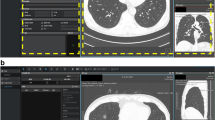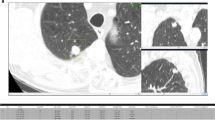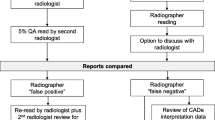Abstract
Objectives
To compare unassisted and CAD-assisted detection and time efficiency of radiologists in reporting lung nodules on CT scans taken from patients with extra-thoracic malignancies using a Cloud-based system.
Materials and methods
Three radiologists searched for pulmonary nodules in patients with extra-thoracic malignancy who underwent CT (slice thickness/spacing 2 mm/1.7 mm) between September 2015 and March 2016. All nodules detected by unassisted reading were measured and coordinates were uploaded on a cloud-based system. CAD marks were then reviewed by the same readers using the cloud-based interface. To establish the reference standard all nodules ≥ 3 mm detected by at least one radiologist were validated by two additional experienced radiologists in consensus. Reader detection rate and reporting time with and without CAD were compared. The study was approved by the local ethics committee. All patients signed written informed consent.
Results
The series included 225 patients (age range 21–90 years, mean 62 years), including 75 patients having at least one nodule, for a total of 215 nodules. Stand-alone CAD sensitivity for lesions ≥ 3 mm was 85% (183/215, 95% CI: 82–91); mean false-positive rate per scan was 3.8. Sensitivity across readers in detecting lesions ≥ 3 mm was statistically higher using CAD: 65% (95% CI: 61–69) versus 88% (95% CI: 86–91, p<0.01). Reading time increased by 11% using CAD (296 s vs. 329 s; p<0.05).
Conclusion
In patients with extra-thoracic malignancies, CAD-assisted reading improves detection of ≥ 3-mm lung nodules on CT, slightly increasing reading time.
Key Points
• CAD-assisted reading improves the detection of lung nodules compared with unassisted reading on CT scans of patients with primary extra-thoracic tumour, slightly increasing reading time.
• Cloud-based CAD systems may represent a cost-effective solution since CAD results can be reviewed while a separated cloud back-end is taking care of computations.
• Early identification of lung nodules by CAD-assisted interpretation of CT scans in patients with extra-thoracic primary tumours is of paramount importance as it could anticipate surgery and extend patient life expectancy.



Similar content being viewed by others
Abbreviations
- CAD:
-
Computer-aided detection
- CT:
-
Computed tomography
- MIP:
-
Maximum intensity projection
References
Mohammed TL, Chowdhry A, Reddy GP et al (2011) ACR Appropriateness Criteria® screening for pulmonary metastases. J Thorac Imaging. 26(1):W1–W3
Hornbeck K, Ravn J, Steinbruchel DA (2011) Outcome after pulmonary metastasectomy: analysis of 5 years consecutive surgical resections 2002–2006. J Thorac Oncol 6(10):1733–1740
Casiraghi M, De Pas T, Maisonneuve P et al (2011) A 10-year single-center experience on 708 lung metastasectomies: the evidence of the ‘international registry of lung metastases’. J Thorac Oncol 6(8):1373–1378
Martini N, McCormack PM (1998) Evolution of the surgical management of pulmonary metastases. Chest Surg Clin N Am 8:13–27
Corona-Cruz JF, Domínguez-Parra LM, Saavedra-Pérez D et al (2012) Lung metastasectomy: long-term outcomes in an 18-year cohort from a single center. Surg Oncol 21(3):237–244
Okumura T, Boku N, Hishida T et al (2017) Surgical outcome and prognostic stratification for pulmonary metastasis from colorectal cancer. Ann Thorac Surg 104(3):979–987
Rubin GD, Lyo JK, Paik DS et al (2005) Pulmonary nodules on multi-detector row CT scans: performance comparison of radiologists and computer-aided detection. Radiology 234(1):274–283
Cerfolio RJ, McCarty TP, Bryant AS (2009) Non-imaged pulmonary nodules discovered during thoracotomy for metastasectomy by lung palpation. Eur J Cardiothorac Surg 35(5):786–791
Cerfolio RJ, Bryant AS, McCarty TP, Minnich DJ (2011) A prospective study to determine the incidence of non-imaged malignant pulmonary nodules in patients who undergo metastasectomy by thoracotomy with lung palpation. Ann Thorac Surg. 91(6):1696–1700
Ross JE, Paik D, Olsen D et al (2010) Computer Aided detection (CAD) of lung nodules in CT scans: radiologist performance and reading time with incremental CAD assistance. Eur Radiol 20(3):549–557
Firmino M, Angelo G, Morais H, Dantas MR, Valentim R (2016) Computer-aided detection (CADe) and diagnosis (CADx) system for lung cancer with likelihood of malignancy. Biomed Eng Online 6 15:2
Parveen SS, Kavitha C (2012) A review on computer aided detection and diagnosis of lung cancer nodules. International Journal of Computers & Technology 3(3):393–400
White CS, Pugatch R, Koonce T, Rust SW, Dharaiya E (2008) Lung nodule CAD software as a second reader: a multicenter study. Acad Radiol 15(3):326–333
Zhao Y, de Bock GH, Vliegenthart R et al (2012) Performance of computer-aided detection of pulmonary nodules in low-dose CT: comparison with double reading by nodule volume. Eur Radiol. 22(10):2076–2084
Jeon KN, Goo JM, Lee CH et al (2012) Computer-aided nodule detection and volumetry to reduce variability between radiologists in the interpretation of lung nodules at low-dose screening computed tomography. Invest Radiol. 47(8):457–461
Schramm A, Wormanns D, Leschber G, Merk J (2011) Reliability of a computer-aided detection system in detecting lung metastases compared to manual palpation during surgery. Interact Cardiovasc Thorac Surg. 12(1):20–23
Traverso A, Cerello AM et al (2015) M5L: A web-based Computer Aided Detection system for automated search of lung nodules in thoracic Computed Tomography scans. Computational Vision and Medical Imaging Processing V:193–199
Torres EL, Fiorina E, Pennazio F et al (2015) Large scale validation of the M5L lung CAD on heterogeneous CT datasets. Med Phys. 42(4):1477–1489
Sahiner B, Heang-Ping C, Hadjiiski LM et al (2009) Effect of CAD on Radiologists’ detection of Lung Nodules on Thoracic CT scans: Analysis of an observer performance study by nodule size. Acad. Radiol. 16(12):1518–1530
Retico A, Delogu P, Fantacci ME, Gori I, Preite Martinez A (2008) Lung nodule detection in low-dose and thin-slice computed tomography. Comput Biol Med. 38(4):525–534
James F, Gruden JF, Ouanounou S, Tigges S, Norris SD (2002) Incremental Benefit of Maximum-Intensity-Projection Images on Observer Detection of Small Pulmonary Nodules Revealed by Multidetector CT. AJR Am J Roentgenol 179:149–157
Hansell DM, Bankier AA, MacMahon H, McLoud TC, Muller NL, Remy J (2008) Fleischner Society: Glossary of Terms for Thoracic Imaging1 Radiology: Volume 246: Number 3-march.
Rosset A, Spadola L, Ratib OJ (2004) OsiriX: an open-source software for navigating in multidimensional DICOM images. Digit Imaging 17(3):205–216
Letourneau PA, Xiao L, Harting MT et al (2011) Location of pulmonary metastasis in pediatric osteosarcoma is predictive of outcome. J Pediatr Surg. 46(7):1333–1337
Campbell I (2007) Chi-squared and Fisher-Irwin tests of two-by-two tables with small sample recommendations. Stat Med 26:3661–3675
Richardson JTE (2011) The analysis of 2 x 2 contingency tables - Yet again. Stat Med 30:890
Beyer F, Zierott L, Fallenberg EM et al (2007) Comparison of sensitivity and reading time for the use of computer-aided detection (CAD) of pulmonary nodules at MDCT as concurrent or second reader. Eur Radiol 17(11):2941–2947
Marten K, Grillhösl A, Seyfarth T, Obenauer S, Rummeny EJ, Engelke C (2005) Computer-assisted detection of pulmonary nodules: evaluation of diagnostic performance using an expert knowledge-based detection system with variable reconstruction slice thickness settings. Eur Radiol. 15(2):203–212
Awai K, Murao K, Ozawa A et al (2004) Pulmonary nodules at chest CT: effect of computer-aided diagnosis on radiologists’ detection performance. Radiology 230:347–352
Goo JM (2011) A Computer-aided diagnosis for evaluating lung nodules on chest CT: the current status and perspective. Korean J Radiol 12(2):145–155
Brown MS, Goldin JG, Rogers S et al (2005) Computer-aided lung nodule detection in CT: results of large-scale observer test. Acad Radiol. 12:681–686
Das M, Muhlenbruch G, Heinen S et al (2008) Performance evaluation of a computer-aided detection algorithm for solid pulmonary nodules in low-dose and standard-dose MDCT chest examinations and its influence on radiologists. Br J Radiol. 81:841–847
Beigelman-Aubry C, Raffy P, Yang W, Castellino RA, Grenier PA (2007) Computed-aided detection of solid lung nodules on follow-up MDCT screening: evaluation of detection, tracking, and reading time. AJR Am J Roentgenol. 189:948–955
Godoy MCB, Kim TJ, White CS et al (2013) Benefit of Computer-Aided Detection Analysis for the Detection of Subsolid and Solid Lung Nodules on Thin- and Thick-Section CT. AJR Am J Roentgenol. 200:74–83
Young S, Lo P, Kim G et al (2017) The effect of radiation dose reduction on computer-aided detection (CAD) performance in a low-dose lung cancer screening population. Med Phys 44(4):1337–1346
Matsumoto S, Ohno Y, Aoki T et al (2013) Computer-aided detection of lung nodules on multidetector CT in concurrent-reader and second-reader modes: a comparative study. Eur J Radiol 82(8):1332–1337
Armato SG 3rd, McLennan G, Bidaut L et al (2011) The Lung Image Database Consortium (LIDC) and Image Database Resource Initiative (IDRI): a completed reference database of lung nodules on CT scans. Med Phys. 38(2):915–931
Jacobs C, van Rikxoort EM, Murphy K, Prokop M, Schaefer-Prokop CM, van Ginneken B (2016) Computer-aided detection of pulmonary nodules: a comparative study using the public LIDC/IDRI database. Eur Radiol 26(7):2139–2147
Funding
The authors state that this work has not received any funding.
Author information
Authors and Affiliations
Corresponding author
Ethics declarations
Guarantor
The scientific guarantor of this publication is Alberto Traverso.
Conflict of interest
The authors of this article declare no relationships with any companies whose products or services may be related to the subject matter of the article.
Statistics and biometry
One of the authors has significant statistical expertise.
Informed consent
Written informed consent was obtained from all subjects (patients) in this study.
Ethical approval
Institutional Review Board approval was obtained.
Methodology
• retrospective
• observational
• performed at one institution
Electronic supplementary material
ESM 1
(DOCX 33 kb)
Rights and permissions
About this article
Cite this article
Vassallo, L., Traverso, A., Agnello, M. et al. A cloud-based computer-aided detection system improves identification of lung nodules on computed tomography scans of patients with extra-thoracic malignancies. Eur Radiol 29, 144–152 (2019). https://doi.org/10.1007/s00330-018-5528-6
Received:
Revised:
Accepted:
Published:
Issue Date:
DOI: https://doi.org/10.1007/s00330-018-5528-6




